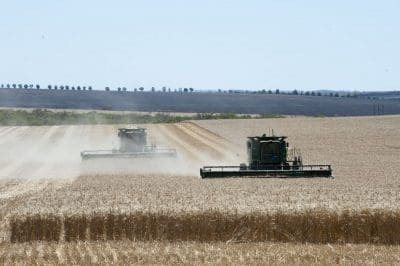TODAY is Australia’s inaugural National Agriculture Day, a day to celebrate Australia’s 25,000 grain farming businesses which each year produce an astonishing amount of grain for consumers in domestic and overseas markets.
 GrainGrowers CEO, David McKeon, said many Australians were unaware of the sheer scale of the grains industry and the value of it to the Australian economy.
GrainGrowers CEO, David McKeon, said many Australians were unaware of the sheer scale of the grains industry and the value of it to the Australian economy.
He said an indicator of the significance of the grains industry was that Australia’s record 2016/17 harvest of 63.4 million tonnes would create a grain pile covering an area equivalent to 15 Sydney Cricket Grounds and higher than the Sydney Tower,
“Grain is one of the largest and most valuable Australian agricultural commodity sectors,” he said.
“In 2016/2017 broadacre cropping directly contributed $17.3 billion to Australia’s national economy and that’s just farm gate value. The cropping sector generated $13.9 billion in export earnings with nearly 40 million tonnes of produce heading overseas, with a growing market from our Asian neighbours.”
Mr McKeon said when Australians think of grain they probably first think of the wheat in their daily bread or pasta.
“Whilst wheat is Australia’s most valuable crop, Australian farmers also grow an astonishing range of grains, legumes (pulse crops) and oilseeds in their farming rotations,” he said.
“These are used to feed both people and farm animals. Some are even used to produce fuel for cars, trucks and aircraft.
“The names of some grains will be familiar, such as oats, delicious in porridge, and barley – and a reminder here that without grain farmers there would be no beer! Others may be less well known, such as triticale, lupins, field peas, canola, chickpeas and faba beans.
“Australian grain farmers also grow the more ‘trendy’ ancient grains such as quinoa, chia, spelt, amaranth, freekeh and teff, although not yet in large quantities.
“Many growers also raise livestock on their farms such as sheep and cattle. In fact, a total of 94,000 people are directly employed in mixed farming. Collectively they crop nearly 24 million hectares of farmland. This is the engine room for a whole range of businesses employing large numbers of Australians including transport companies, railways and ports, flour mills, stockfeed manufacturers, maltsters and brewers, and food manufacturers.
“Family farm ownership continues to dominate Australian grain production with more than 95 per cent of grain farms being family owned and operated. So it is true when we say that Australian grain is proudly grown by our families for yours.
“Moreover, our recent technology survey showed that modern grain farmers are very technically savvy. Farms are getting bigger and so is the machinery they use to bring in the harvest. Some 79 per cent of grain growers now use farm machinery with GPS auto steer, 45 per cent use digital harvest yield maps and 35 per cent utilise satellite imagery.”
Mr McKeon said that as an export-focused industry the value of Australia’s grain exports is impacted by global grain prices, freight rates, international market access arrangements and currency fluctuations.
“That’s why the industry remains focussed on international competitiveness and delivering quality grain sought after by a wide range of local and overseas customers.”
Gobsmacking grain industry statistics
- Area cropped = 23.9 million ha
- Australia’s grains cropping area equates to 1.8 time the total size of England or 7.8 times the size of Belgium.
- Volume of crop production = 63.4 million tonnes
- Carted by trucks from farms all at one time would take 2.4 million grain trucks.
- Volume of crop exports = 39.8 million tonnes
- Australia’s grain exports in 2016/17, if all loaded onto Panamax vessels (60,000 tonnes each), would require 1050 ships
- Farm gate value of crop production = $17.38 billion
- Value of crop exports = $13.9 billion
- If the Australian grains industry was a country, at this level of Gross Domestic Product, it would rank 112th in the world.
(Source: ABARES Agricultural Commodities, June 2017)
Just for fun!
- In 2016/17 Australian farmers produced roughly 2,930,000,000,000,000 individual grains.
- If each grain was lined-up, end-on-end, they would extend 8790 billion kilometres, or go around the circumference of earth 219 thousand times!
- Or, to put it another way, the line of grains would stretch from here to Pluto!
Source: GrainGrowers
The State of the Australian Grains Industry report is available here. http://www.graingrowers.com.au/policy/resources


HAVE YOUR SAY